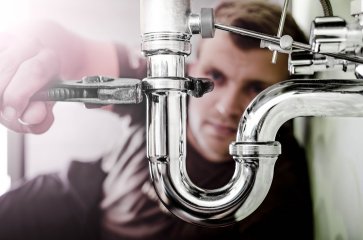3 Plumbing DIYs You Can Handle and 1 You Absolutely Should Not

If you’re used to being the handyman (or woman) around the house, it’s understandable that you’d want to tackle as many of the household projects as possible on your own – and that’s ok! There’s nothing wrong with DIYing some of the issues that arise in your home as long as you’re educated, have the knowledge and the skills to safely perform the repair or adjustment, and are aware of all the ways in which things could potentially go wrong. One of the more common things homeowners run into are plumbing problems. If you’re wondering what might be safe to tackle on your own, and what you should absolutely call in a professional for, here are a few guidelines to help you make that decision. Of course, it’s never a bad idea to call in a professional plumber, service tech, or electrician when you’re having any plumbing, electrical, or heating/cooling issues, either. Don’t ever feel like you have to take on a DIY fix if you’re not fully comfortable with it.
Unclog a Drain
To an extent, unclogging a drain is doable on your own. If you’ve tried a safe, non-corrosive declogging substance and are still running into issues, you can take next steps to try and clear the clog yourself. However, if a simple unclogging method doesn’t work, it’s probably best to call a trusted plumber to step in. The more complex the clog, the more likely you are to put your family’s safety and comfort at risk by trying to go above and beyond your handy skillsets. If you’re trying to get rid of a clog on your own, make sure you have towels and a bucket nearby to help catch any leaks, and of course to contain the substance that was causing the clog in the first place.
Fix a Running Toilet
Running toilets are one of the most common banes to the homeowner existence, as we almost all deal with them at one point or another. Sometimes, it’s as simple as adjusting the floating mechanism and flapper in the upper tank when it gets knocked out of place. Now, that’s an extremely simple DIY, and it’s absolutely a sigh of relief when that’s the only issue you face!
If the fix isn’t quite that easy, there are ways to determine what’s really going on and fix the problem yourself, which Bob Vila discusses here. If none of those issues seem to be the problem, and the running persists, you may be dealing with something a little more serious. One of the most important parts of taking on DIY projects is knowing when it’s time to throw in the towel and call in the big guns, ie. a professional plumber.
Install a Shower Head
Installing a new shower head can be a very simple project. You really only need a few tools, including a pair of pliers and threading tape that will keep your shower head water-tight and properly sealed. The Home Depot walks you through the steps you need to know here – and voila! New shower head installed.
If your shower is several years old, or the shower head you’re aiming to replace is showing signs of serious wear and tear, be aware of those things. Often, DIY articles are written with ideal operating conditions in mind. Aging equipment or excessive use/damage can all factor into making the fix-it-yourself approach more complicated than anticipated. If the DIY doesn’t seem quite so doable once you start, stop what you’re doing and call a professional. After all, it’s better to be safe than sorry, and racking up a big repair bill when you were trying to save a few bucks in the first place is never a fun alternative.
There are circumstances under which a DIY is easy enough to complete, and in those instances, can indeed save you time and money. However, there are plenty of situations that should not be DIYed unless you have professional experience in the area. Our biggest no-no is:
Pipe Work
Though it’s rare that homeowners attempt these kinds of fixes on their own, some still will, and doing so can lead to big problems. When it comes to serious drain clogs, working with old pipe or threaded fittings, or trying to fix a leak on your pressurized domestic water system, you may want to call a professional right away – before you find yourself in over your head.
At the end of the day, there’s a time and a place for DIYs, but knowing where to draw the line in order to keep your family safe and comfortable is key. No matter what’s going on with your home’s plumbing, it never hurts to get a second, professional opinion. We live in a world where DIY is Google-able for pretty much everyone, but just because the information is out there doesn’t mean your expertise matches what’s required to get the job done right, in a way that sticks. Knowing where your skills fall off and where you need assistance is one of the most powerful things you can determine as a homeowner. And when you’ve hit that limit, in the Denver-Boulder area, Save Home Heat is here to help bridge the gap and keep your home as safe and comfy as you need it to be.




